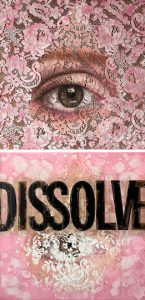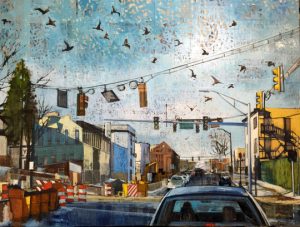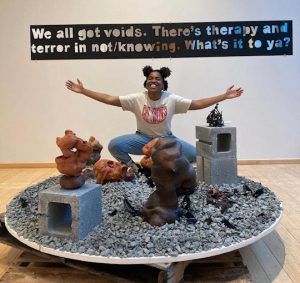This spring seems to be a season of reflection. From singular pieces of art to exhibitions, performances to writings, the world has turned a reflective eye on the past few years. Musings on loss, and love, and mindfulness, and self-care, and solitude, and community, sometimes all wrapped up in the same, thoughtful package. That lens can allow for clarity and a vision for a future that allows for compassion, empathy, and understanding—for the beauty that may exist within the human condition.

A Chapel of Tears, an exhibition opening at the Chris White Gallery in Wilmington, DE on March 31st , brings together over two dozen artists from three continents. Curated by Nanci Hersh, the show explores tears symbolically, with various media and art styles mingling to create a layered display of emotion. “Chapel of Tears stems from personal reflections and conversations I’ve had with others about our current state of being and considers how we can create community amid divisiveness, senseless loss, transition, and uncertainty in the wake of the COVID-19 pandemic,” Hersh explains.
“Tears are symbolic of our liminal/transitional state that we are all currently in,” Hersh continues. “Tears come from a private interior space and move through us, making the invisible, visible.” She reflects on the intense emotions relatable for all of us who have been moved to tears from a variety of feelings. “Tears were often a source of shame for me as a child and younger adult,” she says. “Full of strong feelings and emotions, I felt betrayed by them, evidence to what I perceived as weakness and vulnerability. As an adult, I see them as cathartic, healing, and evidence of our shared humanity.”

The inspiration of the show emerged from an experience shared by many of the participating artists. In August 2022, The European Cultural Academy (ECA) hosted a course titled “Contemporary Art: Framework to Develop your Ideas” in Venice, Italy. “Chapel of Tears was developed through the coursework and my time in Venice visiting the 59th Biennale, the preeminent stage for contemporary art, and the surrounding islands with my cohorts,” Hersh says.
This setting moved many artists. “The inspiration for my tear comes from the cemetery island of San Michele in Venice,” says Bianca Artopé. “I found a huge wall with graves only of children. Most of them from around 1900. In Italy they have pictures of the deceased person on the tomb and plastic flowers which were also already faded.” This intense experience stayed with Artopé. “All these lives not lived. All the grief of the parents.” Artopé transformed photographs of these graves into a hanging sculpture titled lives not lived, a mixed media piece filled with images, butterflies, flowers, and tears, which rotates lightly in the air currents, reminding one of a mobile above a crib. “The shape of the tear is visible but ever-changing,” Artopé says. “When the mobile rotates it comes alive.” It is a moving piece, physically and transcendentally. “Not everyone is allowed to be on this planet for many years, so if you are lucky to be here quite long than you should not just let the years pass by, but intentionally shape your life to the best you can,” she adds.

“We express countless emotions, from intense joy to deep sadness, through our tears,” says Elizabeth Coffey. “Despite our differences, it’s a point of connection.” Her piece, an eye staring at the viewer from a panel of vintage lace, evolved as she connected with the theme of the show. “I had already begun painting my piece when I heard someone suggest that tears dissolve the barrier between the physical and non-physical worlds,” she says. “The word ‘dissolve’ resonated with me. I contemplated the relationship between dissolving and crying, and it ultimately figured very prominently in my piece.” The show led to a renewed passion for some artists in a time lacking in creativity. Misia Denéa, who created a choreo-poem for the exhibition, found it was an essential element in “resuscitating my creative arts practice.” “I contemplated the personal and collective grief of how much the world has changed since March 2020,” they say. Their artwork reflects “the amount of tears I have shed over the lives lost to COVID and continued violence towards marginalized communities as well as the compassion I have for the world and all beings during this era of human history.”
Amy Putnam’s Reflections is another mobile-like structure consisting of tissue boxes hung upside down and covered in newspapers from the past few years. She explains, “of the three collaged tissue boxes, one uses the front page of the New York Times the day America reached one million COVID deaths. Another uses the front page of the New York Times announcing that the Supreme Court overturned Roe V. Wade, and another speaks to the unspeakable plague of gun violence in the United States.”

But there is hope among the tears. “My daughter gave birth at same time I was beginning to think about what I wanted to do,” Laurette Kovary shares. “The materials in my piece came together rather serendipitously showing me that I should create a piece that celebrates life at birth. How our DNA flows like water . . . like tears.” The stew of emotions is the point, in some ways. For example, The Promise by Nadira Husain combines images of hope, loss, and beauty on shedding tears. Their work contemplates “emotional abandonment and the inability of my community to explore and engage in matters of the heart, mind, and soul.”
“I hope it makes people think about all the different aspects of tears–tears of joy and laughter, tears of grief, tears of anger and frustration—it is amazing how this little salty water drop has to do with almost every emotional situation we find ourselves in,” says Artopé. Visitors hopefully will, as Denéa puts it, “understand the cleansing nature of tears on our personal and collective healing.”
“Tears are universal,” Kovary adds. “We all experience this human phenomenon.” Hersh, as she assembles this exhibition, notes that it offers “the creative practice as a ritual and process to facilitate deeper, sometimes difficult conversations for authentic connections, healing, and to see the beauty in our shared humanity.” That gorgeous message may, perhaps, cause some visitors to shed a tear themselves. Chapel of Tears is on view March 31st through May 5th at the Chris White Gallery. The Opening Reception will be held Friday, March 31st from 5 to 9 pm. It will be part of the Wilmington Art Loop on Friday, April 14th from 5 to 9 pm. “The Art of Compassion: Community Conversation; Mixed Media Art Making” workshop will be held Saturday, April 15th from 1 to 3 pm (reservations required). A Closing Reception will be held Friday, May 5th from 5 to 9 pm. The Chris White Gallery is located at 701 N. Shipley Street, Wilmington, DE. More information can be found at ChrisWhiteCDC.org/ChapelofTears.
About Victoria Rose
Victoria Rose (she/her) is an editor, writer, avid reader, self-described geek, and fan of all things creative. Her passion for words has led to her current career as a freelance editor, and she is the owner of Flickering Words, an editing service. When not wielding a red pen (or cursor), she loves reading books of all genres, playing video, board, and word games, baking ridiculous creations to show off on the internet, or enjoying the gorgeous outdoors. She is a board member of the West Chester Film Festival and part of the Thirsty Monsters, a team of streamers from around the world who fundraise for various charities supporting LGBTQIA+ and accessibility rights. She can be found online @WordsFlickering or the Brandywine Art Guide @BrandywineArtGuide.
- Web |
- More Posts(113)





Comments